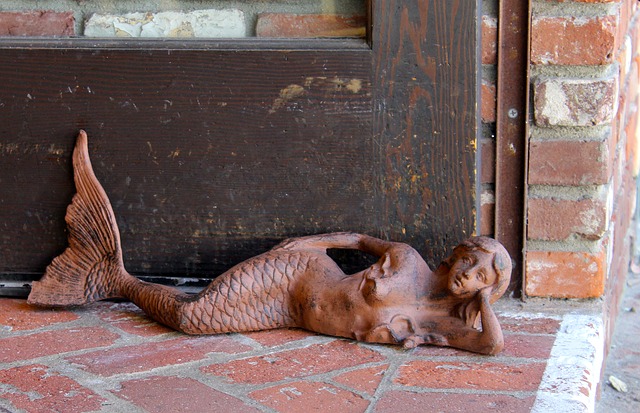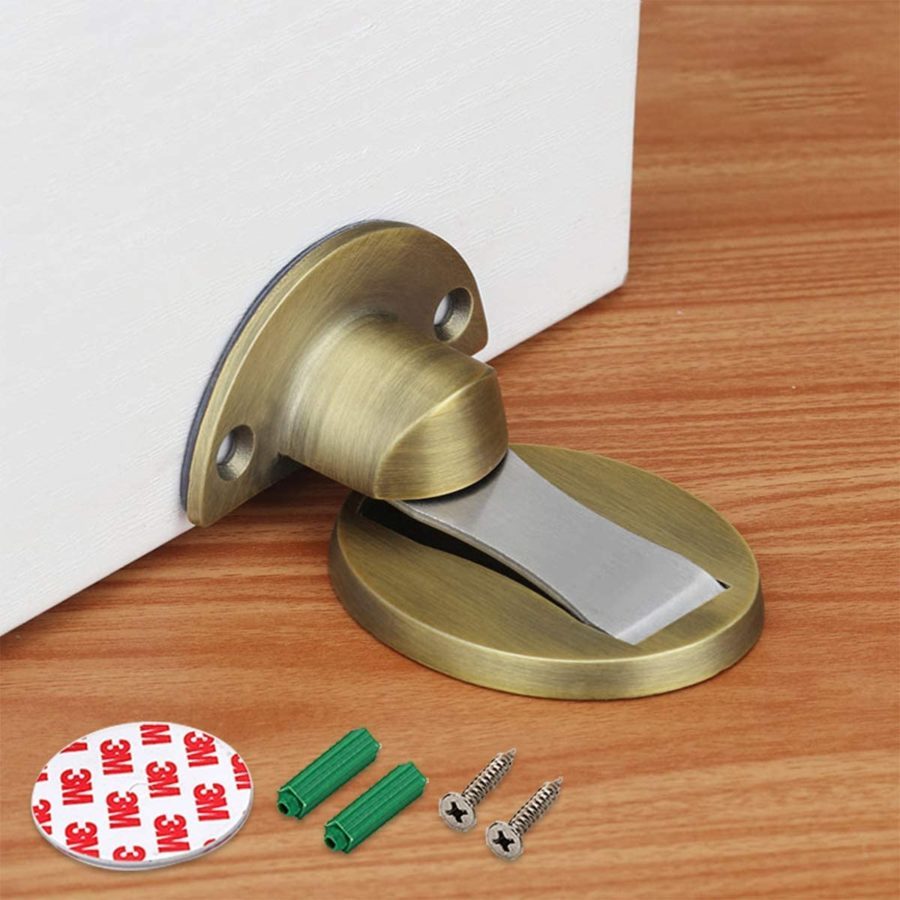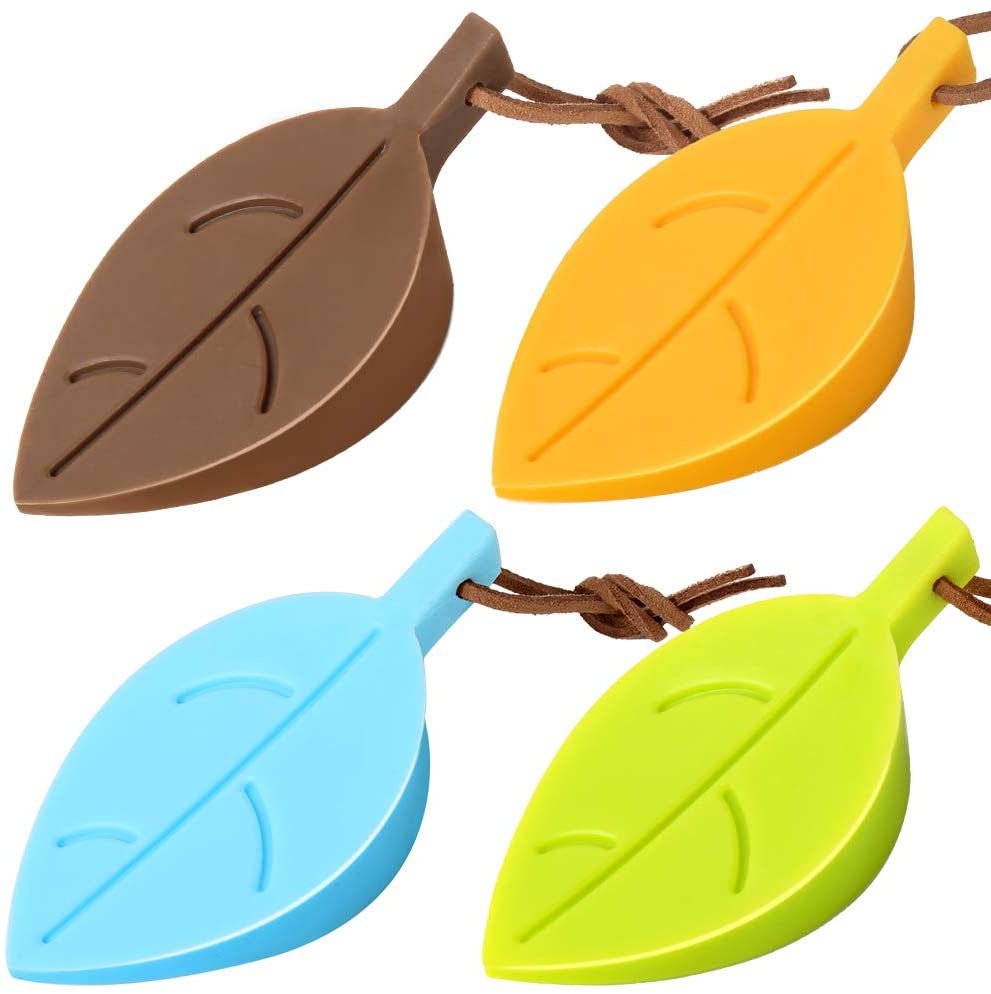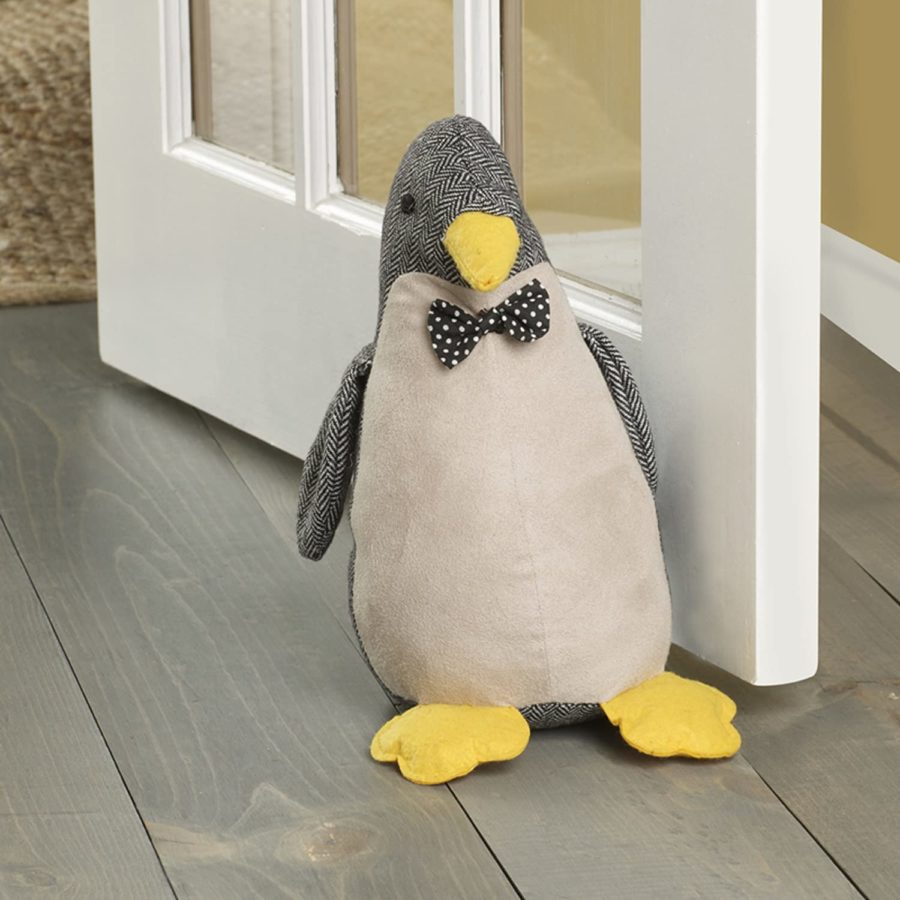
As an Amazon Associate I earn from qualifying purchases.
What can I use as a door stopper? You’ve probably asked yourself this question, most likely after struggling in with the shopping. A door stopper is an essential tool for any household because it can, as the name suggests, stop the door from hitting the wall or skirting behind it. What’s more, some stoppers are versatile and can protect the wall and prevent it from closing again. A door stop is known by a variety of names including door wedge, stopper, and door block.
Stoppers can help hold the door open, as well as keep it closed, if necessary. Most use a stopper to prevent the door slamming into a wall and it reduces the damage done to walls and baseboards. Door stopper installation isn’t as difficult as you might think; installing a front door stopper can be a smart idea. So, what options do you have?
Door Stop Fixtures
You have two choices – wall mounted and floor fitted. Wall mounted stoppers are attached to the wall or baseboard and aren’t as noticeable as floor mounted stoppers. Floor mounted or fixed floor stoppers are installed on the floor but they do the same as wall mounted fixtures. There are also many different types of door stoppers to choose from. So, what door stopper types are available, what’s best for your home or garage, and how to install door stop on door or wall?
Base and Springboard Stops
Baseboard and springboard door stops are incredibly popular and are very similar to one another. They, as the name suggests, are installed onto the baseboard (or the wall) and offer a spring-type construction with a rubber tip. These stop the door bouncing against the wall but there are other door stops similar to these that offer more rigidity that stop the door dead in its tracks.
A key door stopper can be a necessary tool for most households and baseboard stops are a necessity too. These door stops will be effective for households without small children and in particular, kitchen and pantry doorways.
The Magnetic Door Stop
Magnetic door stops are incredibly versatile as they’re suitable for floor or wall mounting, and can stop the damage done to walls by swinging doors. These stops are the ideal choice if you want a stopper that also keeps the door open and is particularly useful for front and back doors. However, they’re versatile enough that they can be used with any door in the home or commercial property. These stops work with magnets so they’re fairly simple to work with, although, they may need to be replaced every so often.
The Hinge Pin Stopper
Hinge pin stoppers are practical and quite discreet. Hinge pin door stop how to install? This is easily done, you will attach the hinge pin to the hinge of the door and there’s no additional hardware needed. This will make it one of the simplest door stops available and they work with different door designs too. Once they’re attached to the hinge of the door, you’re good to go.
A Rubber Door Lock Stopper
These are similar to the baseboard stoppers and are entirely made out of rubber. This helps to protect the door from damage as it hits the stopper and is strong, durable, and long-lasting. You can get many types of stops, including small rubber door stops and they’re discreet too. They will sit neatly behind your door, usually towards the bottom of the wall or baseboard if you want more discretion. It can also be a very small door stopper so it is ideal.
A Bumper Door Stop
Practical as a high door stopper, the wall bumper is a circular or round bumper-type stopper that prevents the doorknob from hitting against the wall. It’s ideal because it’s versatile and easy to install. Also, the bumper door stop is usually wall mounted and is perfect for doors with larger doorknobs or handles that reach the wall.
Fixed Floor Door Stops
There are two reasons why the fixed floor door stop is used; the first is to protect the walls from being damaged and the second is to keep the door open. Attached to the floor, these are easy to install but are more noticeable. These are ideal if a door is constantly being opened and prone to hitting the walls or skirting boards. It’s also ideal for commercial properties.
The Hook Catch Door Stop
These stops are perfect if you need to keep a door open for a prolonged amount of time. It comes with a hook and eyelet which are installed at the very bottom of the door. These are easy stops to install and can be versatile like magnetic stops.
A Rubber Door Wedge
A long handle door wedge can be a useful solution for many households. Door wedges are ideal because they fall into the no drill floor door stop category which means no installation is required. Since it’s made of rubber, the door stop or wedge, won’t damage the door or the flooring. It’s like a door space blocker but how to use a door wedge?
It’s triangularly shaped, with one side raised (which wedges the door open). Where to buy a door wedge? There are many outlets like home depot stores to pick one up, or you could make one yourself. Wedges are high quality door stops and a woody door stopper doesn’t really need any installation. If you want door stops that work, these are it. That doesn’t mean to say the sleeve door lock or magnetic stoppers aren’t good but it’ll depend on the type of stopper you need.
Benefits of Installing a Door Stop
No matter what type of home you have, door stops are useful. They’re a necessity for doors that see heavy foot traffic during the day and can prevent walls and skirting boards from being damaged. Even business properties can benefit from door stops or blockers. A new door stopper will prevent damage to your walls and benefit your home or business.
-
No Trapped Fingers
A 6 door stop can be beneficial when you have children in the home. Children love to explore and when your back is turned, they can wander towards an open door, put their fingers into the door jam and have it suddenly snap shut on them. It’s a nasty and very painful accident and one that could cause serious injury as well. That’s why you should always install some sort of door stop or blocker so children (and pets) don’t injure themselves.
While door blockers or stoppers aren’t just about preventing doors from bouncing off the walls and snapping shut, they’re an ideal tool to have. Installing an under door stopper can be a smart idea and really, it can also become a decorative piece in the home. If you have to use one, you could ensure it’s a decorative one so that it looks nice.
-
No More Damage To Your Home
How many times have you accidentally pushed the door opened a little too forcefully and knocked the door off the wall? A door stopper lock might prevent this. That’s one benefit of installing a door stop. It’ll help prevent damage to the home, especially to the walls and skirting directly behind the door.
-
Convenient For Your Home
You’ve got an armful of shopping; you push the front door open and drop the first load down, along with your keys. Then, you go out for the second load and a gust of wind slams the door shut. It happens and when it does, it’s frustrating, especially when your arms are full of shopping or laundry. With a magnetic door stop you can avoid this from happening. Door stops are convenient for front and back doors and are ideal to prevent damage to your walls and stopping them from unexpectedly closing on you.
What’s The Best Door stop?
Door stoppers vary considerably. Finding the best door stopper is about choosing the right one for your home. For instance, a hook stopper may not be ideal if you have pets or younger children; in that case, magnetic or hinge pin stoppers might be more appropriate. However, this will vary from household. Space availability will play a part in your decision. A fixed wall stopper is useless if the handle is still able to touch the wall and cause damage to it.
This is dependent on the size of the handle and how far it sticks out. In this instance, a fixed-floor stop would be more suitable as it can be placed further away from the wall. On the other hand, rubber stops may be more convenient but again, it’s about what’s practical for the home. Remember, door stops are only useful if they solve the problem. For example, if the door swings open and hit the skirting boards or walls, it would be the problem to fix. So, that’s what you have to think about when deciding the best stopper.
Best door stop for carpet,
When it comes to the best door stop for carpet, you may want to opt for a wall-mounted stopper. Fixed floor stoppers are good but not practical for carpeted areas unless you’re willing to cut through them, which is unlikely. Of course, a small rubber door wedge can be just as good as a wall-mounted stopper, especially if you don’t want to install one on your wall or skirting boards. For practicality, a wall stopper might prove better for carpeted rooms.
For linoleum and wooden floors, fixed floor stoppers might be more suited. Again, it depends on the availability, the actual door, and the area of the home. If you’ve decided on a fixed floor stopper, Fantom door stops are a great choice; you may want to look at a Fantom doorstop review to find out more.
If you want to keep the door open, a magnetic stopper might be more suited. A no slam magnetic door stop might be the one for the job. It uses magnets to keep the door from snapping shut and might be the better option to keep the door open.
DIY Door Stop
Want a personalized door stopper rather than a traditional boring stopper? You could create your own door stop for your garage door or your home front door. It’s easy to do and there are lots of simple, everyday items to get creative with. Best of all, you don’t need a lot of DIY knowledge to get you started. How to make your own door stopper? You could look at the following to get your ideas off the ground.
- Decorative Logs And Stones
- Old Wellington Boots Spray Painted And Filled With Decorative Plants
- A Mason Jar Filled With Potpourri
- Tall Glass Jars Filled With Decorative Pebbles or Beads
- A Basket With Heavy Books
- A DIY-Designed Shoe Or Stopper
There are lots of door stopper ideas to have fun with and it’s a good way to save some money too. You can create unique door stoppers so they fit more discreetly in your home. You could even look at some rubber door stop tips.
How to Install Door Stopper
First, think about door stop placement. You want to measure where the post door stop will sit; carefully mark the wall or floor (with a pencil). You can use this to drill the necessary holes. However, before you start drilling, open the door and match up where the stopper will hit when opened. If you’re using a hinge joint, be extra careful with this part. Magnetic door stopper installation uses magnets so it’s a little easier to work with but must be done correctly so the magnets are aligned properly. Fortunately, they don’t require a lot of skill to install.
-
Where to put door stopper?
If you’re installing a wall mounted fixture, you may want to hide it when the door is opened. In that case, place the stopper towards the bottom of the wall or on the skirting or baseboard. For floor door stop installation, you have to measure the distance from the wall and position where you feel is necessary. With the best door stop design, it’ll be easy to install the stop.
So when you’ve positioned the stopper in the right location, you can drill a hole (this is where the screws will sit) and you may have to use a wall plug depending on the type of stopper being used. Then, the actual stopper can be attached. The stopper should be held in place and then screwed down.
-
How to use door stopper once installed?
How to use door stopper? Once it’s installed, it’s ready to go and you shouldn’t have to do too much. If you’re using a magnetic stopper, you may need to test it to ensure the magnetic fields are aligned properly. How to install door stop on a tile floor? This can be a little trickier but not impossible. It’ll require you to drill into the concrete floor. You’ll have to insert a raw plug to fit in the screw. You have to be careful when you install door stop in concrete. It’s essential to measure twice before doing any drilling because it won’t be possible to undo the drilling.
-
How to install door stop on tile floor?
How to install door stop on tile floor? This is very much similar to drilling into concrete. You will have to carefully position the stopper. When it comes to drilling into the floor, do so slowly so the tile doesn’t crack entirely.
-
How to remove door stopper from wall?
How to remove door stopper from wall? There may come a time when you – for whatever reason – have to remove the stopper. Fortunately, this is fairly easy and will take only a few minutes. So, shut the door and unscrew the attachment from the wall and remove any hardware. The same can be done with floor fixtures. It’s as easy as that. Unfortunately, if you aren’t replacing it with another fixture, you’ll have to fill in the holes left behind.
Do Door Stoppers Work?
If you buy the right stopper, it can be very effective. As said above, you have many types of fixtures to choose from and they’re all fairly easy to work with, even if you’re not a DIY expert. More importantly, door stops can help prevent injuries from occurring, and learning how to put a door stopper on and removing one is easy. It only takes a few minutes.
If you want to know where to buy door stoppers, they’re easily found in home depots, many home store outlets, and online stores will stock them too. You could even make one yourself. Wall mounted and floor fixed door stops are useful and every home should have them. Buy it now.
Amazon and the Amazon logo are trademarks of Amazon.com, Inc, or its affiliates.



